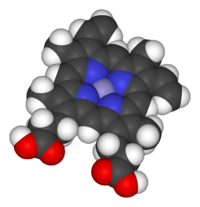
Photo from wikipedia
Photocatalytic processes are present in natural biochemical pathways as well as in the organic synthetic ones. This minireview will cover the field of photocatalysis that uses both the free-base and… Click to show full abstract
Photocatalytic processes are present in natural biochemical pathways as well as in the organic synthetic ones. This minireview will cover the field of photocatalysis that uses both the free-base and specially metallated porphyrins as catalysts. While free-base porphyrins are valuable sensitizers to output singlet oxygen, metalloporphyrins are even more adjustable as photocatalysts because of their coordination capacity, generating a wider range of oxidation reactions. They can be applied in autooxidation reactions, hydroxylations, or direct oxygen transfer producing epoxides. This review will mainly focus on how manganese and some iron porphyrins can be utilized for the functionalization of compounds that have a polycyclic skeleton in their structure. These kinds of compounds are notoriously taxing to obtain and difficult to further functionalize by conventional organic synthetic methods. We have focused on photocatalytic oxygenation reactions in mild conditions with the use of water-soluble porphyrins, as this has been proven to be a good tool for these transformations. In the photocatalytic reactions of some polycyclic heteroaromatic compounds, new polycyclic epoxides, enediones, ketones, alcohols, and/or hydroperoxides are yielded, depending on the catalyst applied. The application of anionic and cationic Mn(III) porphyrins under different reaction parameters results in different reaction pathways generating a vast number of photocatalytic products. Recently, Co and Ni complexes have been also photophysically investigated and confirmed as potential photocatalysts for the functionalization of organic substrates.
Journal Title: International Journal of Photoenergy
Year Published: 2018
Link to full text (if available)
Share on Social Media: Sign Up to like & get
recommendations!